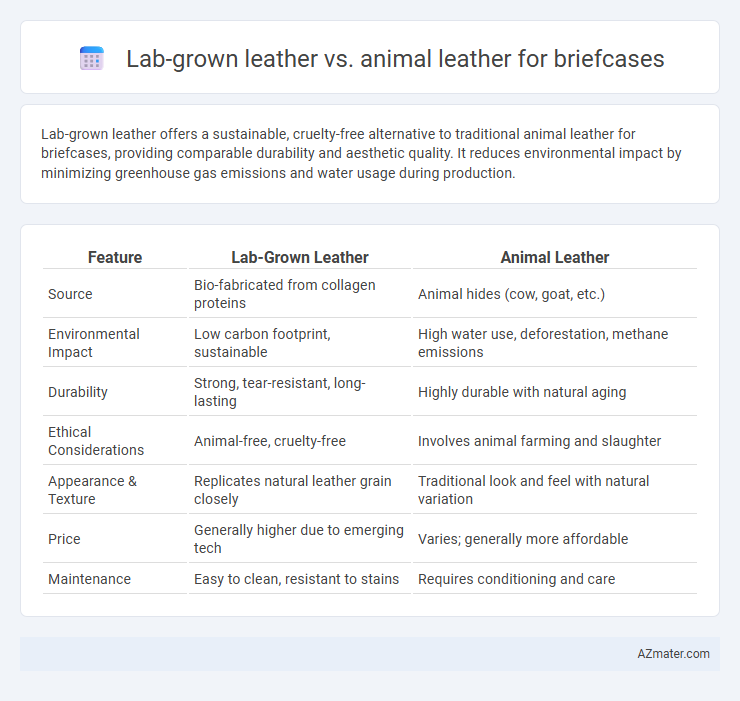Lab-grown leather offers a sustainable, cruelty-free alternative to traditional animal leather for briefcases, providing comparable durability and aesthetic quality. It reduces environmental impact by minimizing greenhouse gas emissions and water usage during production.
Table of Comparison
| Feature | Lab-Grown Leather | Animal Leather |
|---|---|---|
| Source | Bio-fabricated from collagen proteins | Animal hides (cow, goat, etc.) |
| Environmental Impact | Low carbon footprint, sustainable | High water use, deforestation, methane emissions |
| Durability | Strong, tear-resistant, long-lasting | Highly durable with natural aging |
| Ethical Considerations | Animal-free, cruelty-free | Involves animal farming and slaughter |
| Appearance & Texture | Replicates natural leather grain closely | Traditional look and feel with natural variation |
| Price | Generally higher due to emerging tech | Varies; generally more affordable |
| Maintenance | Easy to clean, resistant to stains | Requires conditioning and care |
Introduction to Lab-Grown Leather and Animal Leather
Lab-grown leather, created through cellular agriculture, mimics traditional animal leather by cultivating collagen fibers without animal slaughter, offering an eco-friendly, sustainable alternative for briefcase production. Animal leather, derived from the hides of cows and other livestock, remains prized for its natural durability and distinctive texture but involves higher environmental and ethical costs. Both materials serve the luxury briefcase market, with lab-grown leather aiming to reduce carbon footprint and animal exploitation while maintaining premium quality and aesthetic appeal.
Sustainability: Environmental Impact Compared
Lab-grown leather significantly reduces the environmental footprint compared to animal leather, minimizing water consumption, greenhouse gas emissions, and land use associated with livestock farming. The production process of lab-grown leather eliminates the need for harmful chemicals and deforestation, contributing to a more sustainable lifecycle for briefcases. Choosing lab-grown leather supports reduced waste generation and promotes eco-friendly manufacturing practices within the fashion and accessories industry.
Durability and Longevity of Both Materials
Lab-grown leather offers impressive durability with resistance to cracking and fading, maintaining its structural integrity over time, making it a reliable choice for briefcases subjected to daily use. Traditional animal leather is renowned for its long-lasting strength and ability to develop a unique patina, enhancing its appearance and durability with age. Both materials provide excellent longevity, but lab-grown leather often requires less maintenance while animal leather benefits from natural resilience and repairability.
Ethical Considerations: Animal Welfare vs Innovation
Lab-grown leather offers a sustainable alternative to traditional animal leather by eliminating the need for animal slaughter, addressing major ethical concerns about animal welfare and reducing environmental impact. Innovations in cultured leather technology promise consistent material quality and the potential to scale production without relying on livestock farming. Consumers seeking ethically responsible briefcases increasingly consider lab-grown leather as a cruelty-free option that supports innovation in sustainable fashion.
Aesthetic Qualities: Texture, Color, and Customization
Lab-grown leather offers a consistent and smooth texture that mimics the natural grain of animal leather while allowing precise control over color saturation and finishes, resulting in highly customizable briefcases. Animal leather presents unique, natural variations in texture and color that develop a distinctive patina over time, enhancing the aesthetic appeal of briefcases through aging. Both materials provide aesthetic versatility, but lab-grown leather enables greater design innovation by allowing a broader spectrum of colors and uniform texture without compromising durability.
Cost Comparison: Production and Retail Prices
Lab-grown leather for briefcases generally incurs higher production costs due to advanced biotechnology and limited scale, resulting in retail prices often exceeding those of traditional animal leather. Animal leather benefits from established supply chains and mass production, making it more affordable but subject to price fluctuations based on livestock and tanning industry variables. Consumers face a trade-off between the premium pricing of lab-grown leather's sustainability and innovation versus the cost-effectiveness and durability of conventional animal leather briefcases.
Performance: Water Resistance and Maintenance
Lab-grown leather offers superior water resistance compared to traditional animal leather, reducing the risk of water damage and stains on briefcases. Its synthetic composition allows for easier cleaning and minimal maintenance without the need for specialized conditioners or treatments. Animal leather, while durable, requires regular conditioning to maintain its water resistance and prevent cracking or fading over time.
Market Trends and Consumer Preferences
Lab-grown leather is rapidly gaining market share in the briefcase industry due to increasing consumer demand for sustainable and cruelty-free alternatives. Market trends highlight a shift toward eco-conscious materials, with lab-grown leather offering comparable durability and aesthetic appeal to traditional animal leather. Consumer preferences indicate a growing willingness to pay a premium for innovative, ethically produced briefcases that reduce environmental impact.
Innovations in Lab-Grown Leather Technology
Lab-grown leather for briefcases leverages cutting-edge biotechnology, utilizing cultured animal cells to create sustainable, cruelty-free materials with a significantly lower environmental footprint. Innovations such as improved cell scaffolding and biofabrication techniques have enhanced durability, texture, and aesthetic qualities, rivaling traditional animal leather in luxury and performance. These advancements enable customizable manufacturing processes that reduce waste and resource consumption, positioning lab-grown leather as a viable, eco-conscious alternative for premium briefcase production.
Conclusion: Which Leather is Best for Briefcases?
Lab-grown leather offers sustainable durability and consistent texture, making it an eco-friendly alternative for briefcases without compromising quality. Animal leather provides natural breathability and age-enhancing characteristics, valued for its classic look and long-lasting strength. The best choice depends on consumer priorities: lab-grown leather excels in environmental impact and innovation, while animal leather remains preferred for traditional luxury and proven longevity.

Infographic: Lab-grown leather vs Animal leather for Briefcase
 azmater.com
azmater.com